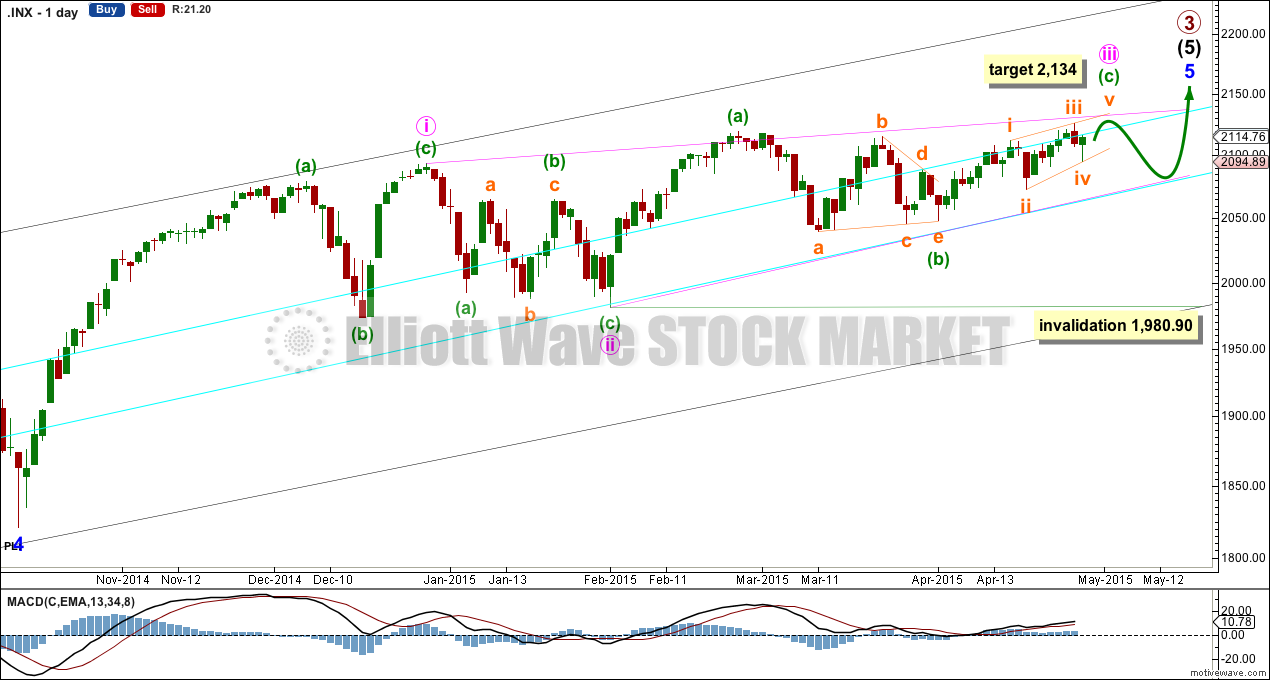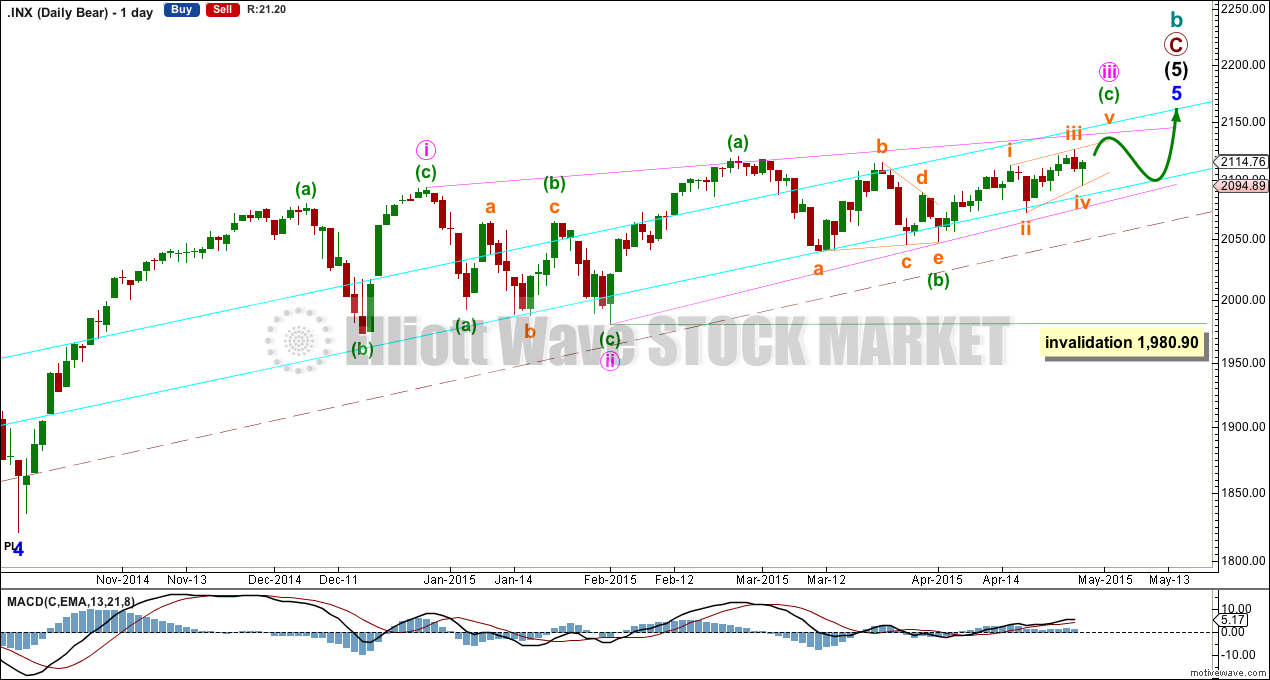Downwards movement was unexpected, although an alternate wave count did allow for it.
Summary: I am changing the wave count at the weekly, daily and hourly chart level. In the short term I expect one more high to 2,134. That may be followed by a deep correction back down to the lower aqua blue line, and it must move below 2,093.55. Thereafter, more upwards movement. Overall, I expect an ending contracting diagonal is unfolding for a final fifth wave (the traditional technical analysis equivalent would be a rising wedge).
Click charts to enlarge.
Bullish Wave Count
At the weekly chart level I want to see a wave count with intermediate wave (3) at just under 2.618 the length of intermediate wave (1), and subdividing perfectly as an impulse. At the weekly chart level intermediate wave (3) has stronger momentum so far than intermediate waves (1) and (5). This third wave cannot be the weakest.
The two bullish daily charts below both see intermediate waves (3) and (4) as labelled here.
There is now quadruple technical divergence between price and MACD. This indicates a maturing trend. For this reason I will keep the main wave count as the less bullish of the two.
I am adjusting the wave count within intermediate wave (5) only.
If intermediate wave (5) is seen as an impulse with a combination for minor wave 2 and a zigzag for minor wave 4 (perfect alternation) then at the weekly chart level minor wave 3 does not have the weakest momentum. Minor wave 3 is 11 points longer than 1.618 the length of minor wave 1. Minor wave 5 is seen as an ending contracting diagonal.
Keep drawing the aqua blue trend lines on weekly and daily charts on a semi log scale as shown. The lower line is repeatedly tested, shallow and long held. It is highly technically significant and should continue to provide support while the S&P is in a bull market.
I was concerned with the breaches of the last main wave count’s trend line, and so I am adjusting it because it looked wrong.
If minor wave 3 ends earlier as labelled on the weekly chart, then minor wave 5 begins here as labelled. All this choppy overlapping movement with declining momentum fits for a diagonal. An ending diagonal requires all sub waves to be zigzags, and the fourth wave must overlap back into first wave price territory. Elliott wave convention is to always draw the trend lines about a diagonal to indicate the structure is a diagonal.
If there is a triangle as labelled here then it may be a B wave within one of the zigzags of the diagonal.
Minute wave iii must subdivide as a zigzag because it is a third wave within a diagonal. At 2,134 minuette wave (c) would reach 0.618 the length of minuette wave (a).
When minute wave iii is over then it will be known if the diagonal is expanding or contracting (a contracting diagonal is more common). When minute wave iii is over then minute wave iv must move back down into minute wave i price territory below 2,093.55. The rule for the end of a fourth wave of a diagonal is it may not move beyond the end of the second wave here below 1,980.90. Minute wave iv may find strong support at the lower aqua blue trend line.
Within this diagonal for minor wave 5 minute wave ii is a 0.41 correction of minute wave i. This is more shallow than the normal depth of 0.66 to 0.81, but in this case it may have been forced to be more shallow than usual by the strong support offered by the lower aqua blue trend line.
A final zigzag up for minute wave v would still be required to complete the entire structure. It would most likely overshoot the i-iii trend line.
I don’t have a target for primary wave 3 to end yet because I don’t think minor wave 5 will exhibit a Fibonacci ratio to either of minor waves 3 and 1, because there is already a ratio between 3 and 1. Likewise at intermediate degree; intermediate waves (1) and (3) have a close ratio so intermediate wave (5) may not exhibit a ratio to either of (1) or (3). The best way to see where this upwards movement is likely to end is the i-iii trend line of the diagonal, as it is likely to be slightly overshot.
I will not publish the very bullish alternate at this stage because it too expects a diagonal is unfolding upwards. The structure and mid term outlook is the same.
Minuette wave (c) must subdivide as a five wave structure, either an impulse or an ending diagonal.
This wave count sees minuette wave (c) as an ending contracting diagonal. The only problem with this wave count today is the structure of subminuette wave ii: this looks like a five wave structure not a three. However, sometimes the S&P has waves which don’t look right at every time frame. I will consider it because the wave count looks right at the daily chart level.
Within the ending diagonal subminuette wave ii is 0.62 of subminuette wave i, and subminuette wave iv 0.58 of subminuette wave iii. The normal range for second and fourth waves of diagonals is between 0.66 to 0.81.
If subminuette wave v has begun then at 2,134 micro wave C would reach equality in length with micro wave A. This is also where minuette wave (c) would reach 0.618 the length of minuette wave (a).
The diagonal of minuette wave (c) is contracting. This limits subminuette wave v to no longer than equality with subminuette wave iii at 2,148.44.
If subminuette wave iv continues lower it may not move beyond the end of subminuette wave ii below 2,072.37.
Bear Wave Count
The subdivisions within primary waves A-B-C are seen in absolutely exactly the same way as primary waves 1-2-3 for the bull wave count. The alternate bull wave count idea also works perfectly for this bear wave count.
To see the difference at the monthly chart level between the bull and bear ideas look at the last historical analysis here.
At cycle degree wave b is over the maximum common length of 138% the length of cycle wave a, at 167% the length of cycle wave a. At 2,393 cycle wave b would be twice the length of cycle wave a and at that point this bear wave count should be discarded.
While we have no confirmation of this wave count we should assume the trend remains the same, upwards. This wave count requires confirmation before I have confidence in it. Full and final confirmation that the market is crashing would only come with a new low below 1,370.58. However, structure and momentum should tell us long before that point which wave count is correct, bull or bear.
This analysis is published about 07:58 p.m. EST.




